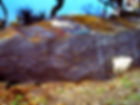
HOOVER POINT
FIELD TRIP STOP – HOOVER POINT (Upper Cambrian Sandstone including Tidal Inlet deposits)
LOCATION: Travel on Route 1431 for approximately 8 miles west of Marble Falls, TX until you reach a roadside overlook onto Lake LBJ found on the south side of the road. Across the pullover, on the north side of the road, is a large outcropping of horizontally layered clastic sedimentary rocks.
GEOLOGIC FEATURES: Crossbeds; Glauconitic sediments; Tidal Inlet paleoenvironment; Normal Fault; Fault Breccia; Cross-Bedding
DESCRIPTION: Here we see beds (layers, strata) of Cambrian age, namely the Cap Mountain and Lion Mountain Members of the Riley Fm as well as the Welge Sandstone and Morgan Creek Limestone Members of the Wilberns Fm.
The most conspicuous lithologic unit seen at this outcrop is the Lion Mountain Member, a sandstone that is dominantly trough cross-stratified and highly glauconitic giving the strata a greenish color. Enclosed within the sandstone are light-colored limestone lenses (or pods). These lenses are filled predominantly with trilobite fragments. The skeletal-rich areas are thought to be analogous to shell lag deposits found in modern-day tidal inlets. The green colorization is thought to result from the glauconitization of clay fecal pellets derived from a landward lagoon and swept into the tidal channel.
In many instances the cross-bedding cuts through the limestone lenses indicating that the lenses formed after deposition of the sediment.. The presence of crossbeds suggest the rapidly moving water in an Upper Cambrian tidal inlet (a tidal pass through a barrier island).
STUDENT QUESTIONS:
(1) How is glauconite formed?
(2) What is cross-bedding (cross-stratification)? How are crossbeds formed?
(3) How does one define a Normal Fault? Compare that to the definition of a Reverse Faultn
(4) How does a fault breccia form?
(5) What is a Tidal Inlet and specifically where is it formed?
(6) What is meant by a Shell Lag Deposit?
SELECTED REFERENCES:
-Barnes, V.E. et al. 1972. Geology of the Llano Region and Austin Area: Field Excursion. Bureau of Economic Geology, University of Texas at Austin. Guidebook 13, 77p.
-Chafetz. H.S. 1978.. A trough cross-stratified glaucarenite: a Cambrian tidal inlet accumulation. Sedimentology, 25, pp. 545-559.
-Chafetz, H.S. 1979. Petrology of Carbonate Nodules from a Cambrian Tidal Inlet Accumulation, Central Texas. Journal of Sedimentary Petrology, 49 (1) p. 215-222.
-Merrill, Glen K. 1980. Road Guide to the Geology of the Llano Region, Central Texas. Guidebook to the Annual Field Trip of the East Texas Geological Society. Oct. 19-21, 1980. Publication No. 80-73, pp. 121-159.
PHOTOS:
_JPG.jpg)
Figure 1 - Outcrop at Hoover Point showing the dark-colored sands with white limestone lenses of the Lion Mountain Member of the Riley Fm (35 ft thick) overlain by the yellowish-brown quartz-rich Welge Sandstone 12 ft.) and then the pinkish-gray Morgan Creek Limestone Member, both of the Wilberns Fm.
_JPG.jpg)
Figure 2 - A unit within the Lion Mountain Member illustrating limestone lenses and crossbedding.
_edited.jpg)
Figure 3 - Close-up of crossbeds and limestone pods.I'm a paragraph.
.jpg)
Figure 4 - Normal Fault cutting through the outcrop.
_edited.jpg)
Figure 5 - Normal Fault with corresponding Fault Breccia within the Lion Mountain Member near the base of the exposed outcrop.
_edited.jpg)
Figure 6 - Close-up of Fault Breccia illustrated in the above photo.
.jpg)
Figure 7 - Fault running through the glauconitic sandstone of the the Lion Mountain Member.

Figure 8 - A piece of the Lion Mountain in the parking area across from the outcrop that provides a 3D view of the cross-bedding.